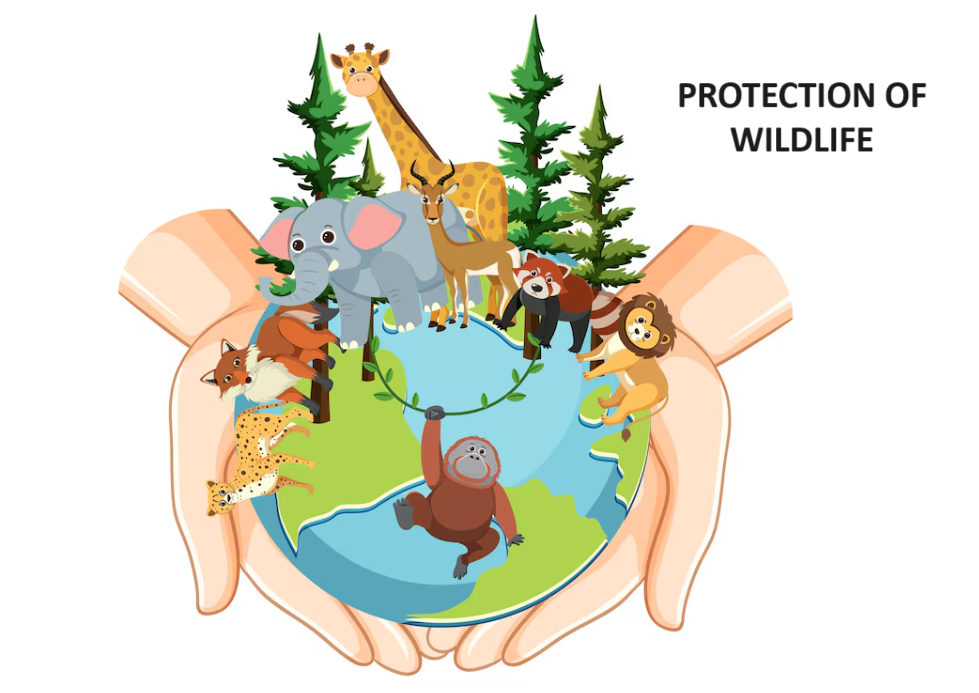Definition of wildlife and its importance in the ecosystem
Wildlife is essential to preserving ecological balance and improving the general health of our world. Nonetheless, several species are in danger of becoming extinct due to different causes. These dangers, which may be man-made or natural, provide serious obstacles to the survival of animal populations all over the globe.
Overview of the various threats faced by wildlife globally
Numerous challenges to wildlife put their existence in jeopardy and upset the delicate balance of ecosystems. Loss of habitat due to human activities, including deforestation, urbanization, and increased agriculture, is one of the biggest dangers. Wildlife animals struggle to find enough food and shelter when their native habitats are destroyed or fragmented. This causes population numbers to drop and may even cause certain species to become extinct.
Overview of poaching and illegal wildlife trade practices
Poaching and the illicit wildlife trade pose a serious danger to wildlife. Numerous animals, including tigers, rhinos, and elephants, are hunted down for their precious body parts, which are in great demand on black markets. In addition to destroying people, this brutal exploitation upsets the natural equilibrium. Furthermore, poachers directly endanger animals by employing poison, snares, and traps, which results in great pain and death.
How climate change is affecting wildlife populations
Wildlife is increasingly facing serious danger from climate change. The availability of resources is altered, and ecosystems are disrupted by severe weather events, rising temperatures, and shifting rainfall patterns. The distribution of species may alter as a result, as may migratory patterns and the timing of important life events like mating and food availability. Whole ecosystems may be affected by these disturbances, which may have a knock-on effect on species and the services they provide, such as seed distribution and pollination. To lessen the effects of climate change and save fragile animal species, immediate action is required.
Main threats to wildlife, conservation efforts and helping protect wildlife for future generations
Loss of Habitat and Fragmentation
The loss and fragmentation of animal habitats is one of the biggest dangers facing them. Natural habitats are being lost or changed as a result of the growing human population in order to create room for infrastructural development, urbanization, and agriculture. Wildlife must compete with one another for a few resources as a result of habitat loss, which upsets the natural equilibrium.
When vast tracts of habitat are split up into smaller, isolated bits, it’s called habitat fragmentation. Because of this fragmentation, animals cannot travel as freely and find it more difficult to locate partners, food, and adequate habitats. Many species, therefore, find it difficult to live in these dispersed environments.

Poaching and Illegal Wildlife Trade
Many species are seriously threatened by poaching and the illicit wildlife trade, especially those with high market value. The unlawful shooting and capture of animals is fueled by the high prices that wildlife items like ivory, rhino horn, and exotic pets command on the black market.
Encroachment of human settlements on wildlife habitats
In addition to endangering specific species, this illicit trade also disturbs whole ecosystems. For instance, the poaching of elephants for their tusks has resulted in a population decrease, which has an impact on the equilibrium of savannah ecosystems, where elephants are essential for controlling vegetation and dispersing seeds.
How climate change is affecting wildlife populations
Climate change poses a serious risk to animals. Extreme weather events, altered precipitation patterns, and rising temperatures may all interfere with many species’ normal habitats and reproductive cycles. A few species could find it difficult to adjust to these changes, which might result in population decreases or possibly extinction.
Rising temperatures, extreme weather events, and their impact on wildlife
Coral bleaching brought on by increased ocean temperatures jeopardizes the fragile ecosystems that sustain a wide variety of marine species, while rising sea levels brought on by climate change pose a threat to sea turtle breeding sites.
Water, air, and land pollution and their detrimental effects on wildlife
Wildlife is seriously threatened by pollution, both in the air and the water. Chemical pollutants, which include industrial waste and pesticides, may pollute food supplies and habitats, causing sickness and problems with reproduction in animal populations.
Plastic pollution and its threat to marine life
In addition, marine life is seriously endangered by plastic pollution in rivers and seas. Many marine animals confuse plastic waste for food, and as a consequence, they swallow it or get entangled in it, which may be fatal.
Invasive species and their impact on native wildlife
When invasive species are unintentionally or deliberately brought into new environments, it may have catastrophic consequences for local fauna. Due to their often lack of natural rivals or predators, many non-native species are able to outcompete and supplant native species.
Overview of conservation initiatives to protect wildlife
For instance, Guam’s introduction of the brown tree snake resulted in the loss of many bird species. Due to the snake’s lack of natural predators in Guam, native birds and their eggs are its primary food source, which has resulted in a sharp drop in bird numbers.
Importance of raising awareness and taking action to preserve biodiversity
It will need the combined efforts of governments, organizations, and people to protect wildlife from these dangers. The future of our priceless species may be protected by conservation efforts including habitat preservation, anti-poaching campaigns, and sustainable practices, which can help lessen these risks.
We may try to create a more sustainable and peaceful coexistence with the many animals that share our world by comprehending and tackling the difficulties experienced by nature.
Various types of threats to wildlife are
Deforestation Affects Animals
Ocean Acidification affects animals
Overexploitation affects animals
Pollution Affects Animals
Illegal Wildlife Trade affects animals
Climate change affects animals
Culling affects animals
Poaching affects animals
Habitat destruction affects animals
